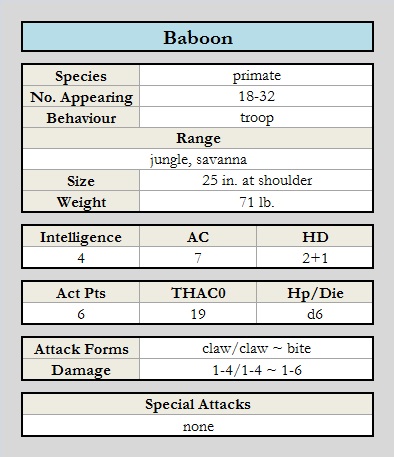Difference between revisions of "Mandrill"
Tao alexis (talk | contribs) (Created page with "Placeholder.") |
(Import from Tao's wiki. Image needed.) |
||
| Line 1: | Line 1: | ||
| − | + | [[File:Baboon image.jpg|440px|left|Baboon]][[File:Baboon chart.jpg|right]] | |
| + | |||
| + | An old world monkey indigenous to the Bornu Empire, the jungles of the Cameroons and the basin of the Congo river. Mandrills live in tropical rainforests, in very large groups. They have an omnivorous diet consisting mostly of fruits and large insects. Their mating season peaks in July to September, so that tribes will be possessed of immature infants from December to April. | ||
| + | |||
| + | Males weigh about 70 lbs., with females weighing a mere 27 lbs (d4/[[Hit Dice|HD]]). Exceptionally large males may weigh up to 115 lbs. The males are some 34 in. long but are rarely outstretched, so that the shoulder height while on the ground is typically about 25 in. Females are naturally shorter and smaller, sitting about 20 in. above the ground. A mandrill's body is compact and muscular; they are possessed with canines up to 2½ in. long. | ||
| + | |||
| + | Mandrills live in very large, stable groups named 'hordes.' This can be hundreds of individuals, usually roaming in loosely connected groups, each numbering about 80—120 members; these hordes will be composed almost entirely of females and offspring. About 12—48 males will live in solitary circumstances outside of a horde, entering only when females are receptive. | ||
| + | |||
| + | Mandrill baboons are rarely threatening unless threatened. Villagers sometimes hunt them for bushmeat. [[Alchemy (sage study)|Alchemists]] have been known to hunt baboons to obtain their teeth or blood. If approached, baboons will make a great deal of noise, while the horde moves away. Males that are approached will roar and make threatening movements before engaging. | ||
| + | |||
| + | See [[Bestiary|Bestiary]]. | ||
| + | |||
| + | [[Category:Bestiary]] | ||
Revision as of 15:31, 11 February 2020
An old world monkey indigenous to the Bornu Empire, the jungles of the Cameroons and the basin of the Congo river. Mandrills live in tropical rainforests, in very large groups. They have an omnivorous diet consisting mostly of fruits and large insects. Their mating season peaks in July to September, so that tribes will be possessed of immature infants from December to April.
Males weigh about 70 lbs., with females weighing a mere 27 lbs (d4/HD). Exceptionally large males may weigh up to 115 lbs. The males are some 34 in. long but are rarely outstretched, so that the shoulder height while on the ground is typically about 25 in. Females are naturally shorter and smaller, sitting about 20 in. above the ground. A mandrill's body is compact and muscular; they are possessed with canines up to 2½ in. long.
Mandrills live in very large, stable groups named 'hordes.' This can be hundreds of individuals, usually roaming in loosely connected groups, each numbering about 80—120 members; these hordes will be composed almost entirely of females and offspring. About 12—48 males will live in solitary circumstances outside of a horde, entering only when females are receptive.
Mandrill baboons are rarely threatening unless threatened. Villagers sometimes hunt them for bushmeat. Alchemists have been known to hunt baboons to obtain their teeth or blood. If approached, baboons will make a great deal of noise, while the horde moves away. Males that are approached will roar and make threatening movements before engaging.
See Bestiary.
